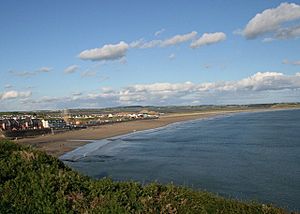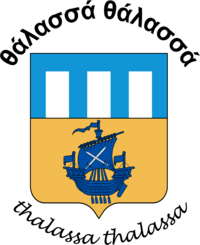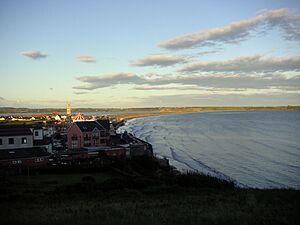Tramore facts for kids
Quick facts for kids
Tramore
Trá Mhór
|
||
|---|---|---|
|
Town
|
||

Tramore Beach
|
||
|
||
| Motto(s):
θάλασσά θάλασσά thalassa thalassa (Greek)
"The Sea, The Sea" |
||
| Country | Ireland | |
| Province | Munster | |
| County | Waterford | |
| Area | ||
| • Total | 4.96 km2 (1.92 sq mi) | |
| Elevation | 20 m (70 ft) | |
| Population
(2022)
|
||
| • Total | 11,277 | |
| Eircode routing key |
X91
|
|
| Telephone area code | +353(0)51 | |
| Irish Grid Reference | S576014 | |
Tramore (pronounced "tra-MOR") is a fun seaside town in County Waterford, located on the southeast coast of Ireland. Its name, "Trá Mhór" in Irish, means "big beach."
In 2022, about 11,277 people lived in Tramore. This makes it the second-largest town in County Waterford. It's a popular spot for holidays and water sports.
Contents
Discovering Tramore's History and Growth
Tramore started as a small fishing village. But everything changed when the railway arrived from Waterford City in 1853. The town quickly became a popular place for tourists.
As more people moved to Tramore in the late 1900s, it became a "dormitory town." This means many people who work in Waterford City (about 13 kilometers or 8 miles away) live in Tramore. Today, Tramore is famous for surfing and other water sports. Its large, sheltered bay is perfect for these activities.
Exploring Tramore's Geography
Tramore is located on the northwest side of Tramore Bay. The town sits on a hill that gently slopes down to a long sandy beach, called a "strand." This strand separates the bay from a tidal lagoon known as the "Backstrand."
The sand dunes and the Backstrand in Tramore are very important for nature. They have been named a Special Area of Conservation by the National Parks & Wildlife Service. The Tramore Eco Group works hard to protect the environment and wildlife in these special areas.
Ancient History: Archaeology in Tramore
The area around Tramore has many ancient stone structures called megaliths. These include places like Ballindud Cromlech, Ballynageeragh Portal Tomb, Knockeen Dolmen, and Gaulstown Portal Tomb. These structures show that people lived here a very long time ago, even before Christianity.
Tramore's Past: Key Events
Records show that a settlement existed in Tramore as early as 1809, when a church was built. An old book from 1837 mentions that the Drumcannon Parish, which included Tramore, had 4,835 residents. At that time, Tramore also had schools and a special house for poor people called an almshouse.
The Sea Horse Tragedy of 1816
On January 30, 1816, a ship called the Sea Horse sank in Tramore Bay. It was carrying soldiers from the 59th Regiment of Foot, along with many women and children. Sadly, 292 men and 71 women and children lost their lives in this terrible accident.
Today, you can find a monument on Doneraile Walk that remembers this event. An obelisk (a tall, thin stone pillar) marks a burial spot at Christ Church on Church Road. Because of this tragedy, the image of a seahorse became a symbol for the town of Tramore. Later, in 1955, Waterford Crystal also adopted the seahorse as its logo.
The Metal Man: A Seafarer's Warning
From the sea, Tramore Bay can look very similar to the safe Suir estuary. After the Sea Horse sank, the ship's insurers, Lloyd's of London, paid for piers and tall pillars to be built. These pillars were meant to help sailors avoid similar accidents. They were put up in 1823, with three on Newtown Head and two on Brownstown Head.
"The Metal Man" is a 3-meter (about 10-foot) tall metal statue of a sailor. He stands on the middle pillar on Newtown Head, pointing out to sea. Local stories say he warns sailors away from dangerous shallow waters by calling out, "keep off, keep off, good ship from me, for I am the rock of misery."
The Guillamene: Historic Swimming Coves
The Newtown and Guillamene swimming coves are beautiful spots located near Cliff Road, at the bottom of Newtown Head. For many years, until the early 1980s, the Guillamene was only for men to swim. Women and children were expected to swim at Newtown.
Today, the "men-only" sign is still there as a reminder of the past. However, both coves are now popular with swimmers of all ages and genders.
The Waterford and Tramore Railway: A Unique Line
Before the late 1700s, Tramore was just a small fishing village. In 1853, a special railway line opened. It was 12 kilometers (7 miles) long and connected Waterford's Railway Square to Tramore. This railway was unique because it wasn't connected to any other train lines. It served the town until it closed on January 1, 1961.
The Pickardstown Ambush: A Moment in History
On the night of June 6, 1921, during the Irish War of Independence, about 50 local Irish Republican Army (IRA) volunteers tried to ambush British troops. The troops were coming from Waterford City to Tramore. The ambush happened at Pickardstown, about a mile north of Tramore.
The plan did not go well because it was too dark to see clearly. Sadly, two IRA men died, and two more were injured. Tramore's Micheál MacCraith GAA Club is named after one of the volunteers who died that night.
| Historical population | ||
|---|---|---|
| Year | Pop. | ±% |
| 1813 | 726 | — |
| 1821 | 889 | +22.5% |
| 1831 | 2,224 | +150.2% |
| 1841 | 1,120 | −49.6% |
| 1851 | 1,882 | +68.0% |
| 1861 | 1,847 | −1.9% |
| 1871 | 2,011 | +8.9% |
| 1881 | 2,036 | +1.2% |
| 1891 | 1,850 | −9.1% |
| 1901 | 1,733 | −6.3% |
| 1911 | 1,644 | −5.1% |
| 1926 | 1,812 | +10.2% |
| 1936 | 2,047 | +13.0% |
| 1946 | 2,379 | +16.2% |
| 1951 | 2,825 | +18.7% |
| 1956 | 2,919 | +3.3% |
| 1961 | 2,882 | −1.3% |
| 1966 | 3,271 | +13.5% |
| 1971 | 3,792 | +15.9% |
| 1981 | 5,635 | +48.6% |
| 1986 | 5,999 | +6.5% |
| 1991 | 6,064 | +1.1% |
| 1996 | 6,536 | +7.8% |
| 2002 | 8,305 | +27.1% |
| 2006 | 9,635 | +16.0% |
| 2011 | 10,328 | +7.2% |
| 2016 | 10,381 | +0.5% |
| 2022 | 11,277 | +8.6% |
Tramore: A Popular Tourist Spot
Tramore has always been a favorite place for Irish tourists. It offers a classic seaside experience with ice cream, a fun fairground, and a beautiful beachfront. The town boasts 5 kilometers (about 3 miles) of beach and sand dunes that look out over the Atlantic Ocean. Tramore is especially well-known for its surfing.
Waterford and Tramore Racecourse: Horse Racing Fun
Tramore is famous for its horse-racing festival, which has been held every August for over 200 years. In the past, the horses used to race right along the sandy beach! Later, a special racecourse was built.
Soon after the railway arrived, Lord Doneraile and James Delahunty built a racecourse at Riverstown. Racing continued there until 1911, when the sea eventually took over the area. Even today, at low tide, you can still see parts of the old racecourse from the back strand.
The current Tramore Racecourse was built at Graun Hill in 1912. This course has been improved over the years and is now also used for shows and music events.
Surfing in Tramore: Catching Waves
| Surfing / Tramore | |
|---|---|
| BREAK TYPE | beach |
| WAVE DIRECTION | right and left |
| IDEAL WIND | North |
| IDEAL SWELL | southerly |
| IDEAL TIDE | Mid-high |
| HAZARDS | None |
| AVERAGE WATER TEMPS | 9 °C – 15 °C |
Tramore has become a very well-known place for surfing in Ireland. It's also popular for other water sports like kitesurfing and windsurfing. The sport of surfing first came to Tramore in 1967, thanks to an Irish surfing pioneer named Kevin Cavey. There are many great places to surf in and around Tramore, including Killmurren Cove, Dunmore East, Bunmahon, and Annestown.
Famous People from Tramore
- Shay Brennan, a footballer for Manchester United, passed away here.
- John Edward Carew, a talented sculptor, was born in Tramore.
- Mary D. Cullen, born in 1929, received her education here.
- Jim Goodwin, a football player and manager, was born here.
- Gordon MacWhinnie, a businessman in Hong Kong, was born here.
- George Morrison, a documentary filmmaker, was born here.
- Edward J. Phelan, a civil servant and the first Director-General of the International Labour Organisation, was born here.
- Louise Richardson, a political scientist and former Vice-Chancellor of Oxford University, was born here.
- Derrick Williams (footballer), a footballer for LA Galaxy, lived here when he was young and played for Tramore A. F.C..
- Lafcadio Hearn, a famous writer, spent his childhood years in Tramore.
See also
 In Spanish: Tramore para niños
In Spanish: Tramore para niños





